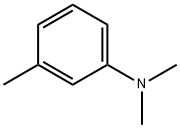- N,N-Dimethyl-m-toluidine
-

- $15.00 / 1KG
-
2021-07-13
- CAS:121-72-2
- Min. Order: 1KG
- Purity: 99%+ HPLC
- Supply Ability: Monthly supply of 1 ton
|
| | N,N-DIMETHYL-M-TOLUIDINE Basic information |
| Product Name: | N,N-DIMETHYL-M-TOLUIDINE | | Synonyms: | Benzene, 1-(dimethylamino)-3-methyl-;Benzeneamine,N,N,3-trimethyl-;Dimethyl-m-toluidine;Dimetil-m-toluidina;m,N,N-trimethylaniline;m-Methyl-N,N-dimethylaniline;m-Toluidine, N,N-dimethyl-;N,N,3-Trimethylaniline | | CAS: | 121-72-2 | | MF: | C9H13N | | MW: | 135.21 | | EINECS: | 204-495-6 | | Product Categories: | Amines;C9 to C10;Nitrogen Compounds | | Mol File: | 121-72-2.mol |  |
| | N,N-DIMETHYL-M-TOLUIDINE Chemical Properties |
| Hazard Codes | T | | Risk Statements | 23/24/25-33-52/53 | | Safety Statements | 28-36/37-45-61 | | RIDADR | UN 2810 6.1/PG 3 | | WGK Germany | 2 | | RTECS | XU5798000 | | TSCA | Yes | | HazardClass | 6.1 | | PackingGroup | II | | HS Code | 29214300 | | Toxicity | LD50 intraperitoneal in mouse: 300mg/kg |
| | N,N-DIMETHYL-M-TOLUIDINE Usage And Synthesis |
| Chemical Properties | clear yellow liquid | | Uses | N,N,3-Trimethylaniline, is an building block used for the synthesis of more complex compounds, such as BTK (Bruton''s tyrosine kinase) inhibitor. | | Uses | N,N-Dimethyl-m-toluidine may be used in chemical synthesis studies. | | General Description | A clear colorless liquid with an aromatic odor. Density 0.932 g / cm3 (Lancaster) and insoluble in water. Hence floats on water. Toxic by skin absorption and inhalation. Flash point 185°F. May release toxic vapors when burned. | | Air & Water Reactions | Tends to darken upon exposure to air. Insoluble in water. | | Reactivity Profile | N,N-DIMETHYL-M-TOLUIDINE neutralizes acids in exothermic reactions to form salts plus water. May be incompatible with isocyanates, halogenated organics, peroxides, phenols (acidic), epoxides, anhydrides, and acid halides. May generate hydrogen, a flammable gas, in combination with strong reducing agents such as hydrides. | | Health Hazard | TOXIC; inhalation, ingestion or skin contact with material may cause severe injury or death. Contact with molten substance may cause severe burns to skin and eyes. Avoid any skin contact. Effects of contact or inhalation may be delayed. Fire may produce irritating, corrosive and/or toxic gases. Runoff from fire control or dilution water may be corrosive and/or toxic and cause pollution. | | Fire Hazard | Combustible material: may burn but does not ignite readily. When heated, vapors may form explosive mixtures with air: indoors, outdoors and sewers explosion hazards. Contact with metals may evolve flammable hydrogen gas. Containers may explode when heated. Runoff may pollute waterways. Substance may be transported in a molten form. | | Purification Methods | Reflux it for 3hours with 2 molar equivalents of Ac2O, then fractionally distil it under reduced pressure. Alternatively, dry over BaO, distil and store it over KOH. The hydrochloride has m 176o (from EtOH) and the picrate has m 131o. Methods described for N,N-dimethylaniline are applicable. [Beilstein 12 H 857, 12 III 1953, 12 IV 1815.] |
| | N,N-DIMETHYL-M-TOLUIDINE Preparation Products And Raw materials |
|